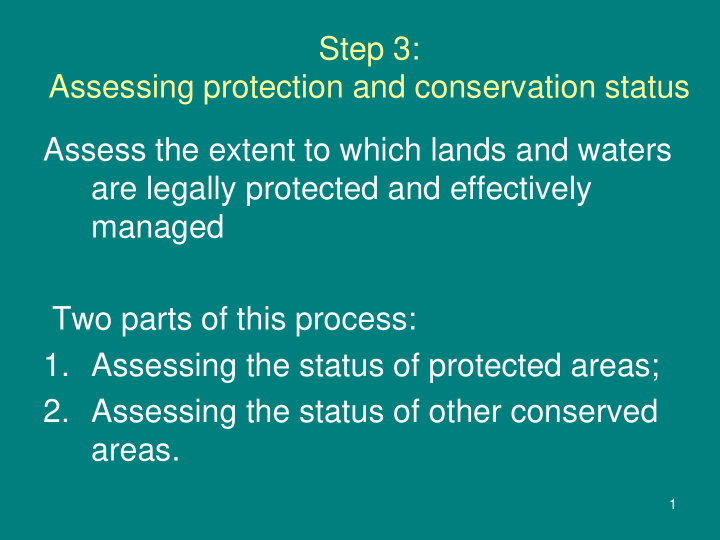



Step 3: Assessing protection and conservation status Assess the extent to which lands and waters are legally protected and effectively managed Two parts of this process: 1. Assessing the status of protected areas; 2. Assessing the status of other conserved areas. 1
1.1 Assessing the status of PA (1/3) Definition of a PA “A clearly defined geographical space, recognized, dedicated and managed, through legal or other effective means, to achieve the long-term conservation of nature with associated ecosystem services and cultural values ”. Tool: IUCN categories and governance types. 2
1.1 Assessing the status of PA (2/3) IUCN’s Protected Area categories : Ia - PA for science Ib - PA for wilderness protection II - PA for ecosystem protection and recreation III - PA for conservation of specific natural features IV – PA for conservation through management intervention V - PA for landscape/seascape conservation or recreation VI – PA for the sustainable use of nature resources 3
1.1 Assessing the status of PA (3/3) PA categories by governance type : – Government management; – Co-management or collaborative management; – Community-conserved areas; and – Private protected areas. IUCN categories and governance types can be a useful tool when mapping and assessing protection status: • indicate degree of protection • identify connectivity gaps in protection 4
1.2 Assessing PA management effectiveness (1/2) Methodologies, guides, case studies, analysis… contain the following elements: • Context: threats, policy environment • Planning: PA design and planning • Inputs: resources needed to carry out management • Processes: the way in which management is conducted 5
1.2 Assessing PA management effectiveness (2/2) • Outputs: – the implementation of management programs and actions; – delivery of products and services • Outcomes: – Assessment of the results of management actions; – The extent to which they achieved objectives. * Adv.: pinpoint the strengths, weaknesses and threats within PAs * Dis.: issues of connectivity are not included in a PA management effectiveness assessment. 6
Assessing and measuring other conserved areas and sustainable use areas (1/4) Definition : “other conserved areas” (OCA) or “sustainable use areas” (SUA) = lands and waters that are not part of a legally-designated PA. Current situation : • OCA and SUA facilitate the maintenance of connectivity at a landscape scale; • OCA or SUA may also provide significant ecological benefits. BUT • most planning processes focus exclusively on legal PA w/o considering other alternatives. 7
Assessing and measuring other conserved areas and sustainable use areas (2/4) Types of other conserved areas: – Legally-established system (reserves) – Third party certification (Stewardship Council, certification) – Second party certification (ISO standards & certification) – Voluntary agreements (Codes of practice, agreement, protected sites...) 8
Assessing and measuring other conserved areas and sustainable use areas (3/4) Challenges of using OCA, SUA – no commonly agreed upon classification system of other conserved areas Tool: a system for – measuring the contribution of OCA and – assessing their contribution to connectivity 9
Assessing and measuring other conserved areas and sustainable use areas (4/4) Five parameters for measuring OCA include: – Biodiversity value – Biodiversity planning instruments – Amount of modification – Permanence – Social sustainability 10
Vietnam‟s c ase Vietnam‟s context: • High biodiversity value, • High population, • Limited NR-land per capita, • Poverty. conservation in human-dominated landscape • Governance (conflict of interests => reconcialation, prioritisation, coordination). 11
Vietnam‟s c ase Five categories of PAs: National Park (IUCN‟s category II) 1. 2. Nature Conservation Area (NCA) • Nature Reserve (I) • Species and Habitat Conservation Area (IV) 3. Landscape Conservation Area (III&IV) 4. Scientific Forest In the NP and NCA, there are three zones: strict protection zone, ecosystem rehabilitation zone and service- administration zone (tourism sub-zone, administration sub-zone and residential sub-zone) 12
Vietnam‟s c ase Governance: – NPs managed by Ministry of Agriculture and Rural Development / Forest Protection Department; – NPs and PAs managed by provinces, districts, forest protection sub-departments, Department of Agriculture and Rural Development and others, even some PAs have no management authority; – Co-management and collaborative management are encouraged but just piloted and results are limited. 13
Vietnam‟s c ase Conservation as a component of rural land use. Evaluation of conservation criteria at the landscape level, it includes an assessment of existing PAs but is by no means limited by their boundaries; A picture of conservation values of the entire landscape is built up by analysing • field conservation measures, • biological and physical information, and • geographical analysis of forest cover. 14
Vietnam‟s c ase • Each conservation value, or criteria, is graded and forms a layer in a cumulative analysis; • Put all the layers together and the resulting map will show biodiversity „hotspots‟, • In most cases, the biodiversity-rich areas, representing priorities for conservation management, will not be restricted to the defined PAs within the landscape. The goal of this systematic analysis is to establish conservation as a component of rural land use. 15
Vietnam‟s c ase • 2001-2004 helped Bac Kan FPSD in development, designation and management of the „South Xuan Lac Species and Habitat Conservation Area‟ and its buffer zone. • Aim: – conserve a suite of national and international biodiversity values, and – implement pilot project for collaborative management of a PA involving local community. • Process: main activities include – biodiversity rapid survey (=>Biological values include many fauna rare and threatened species, Tonkin Snub-nosed monkey, Francois Langur and night heron), – identification of potential reserve location, – preliminary reserve design, – site nomination, – information gap identification, – detailed stakeholder consultation 16
Recommend
More recommend